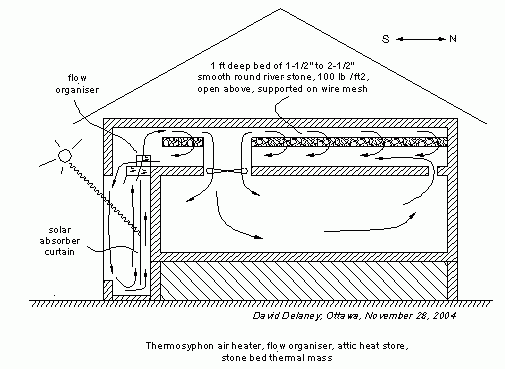 A house in Ottawa,
Ontario (45.3N, 75.6W, continental climate) can get 100% of its
winter space heat from the sun in the thermal scheme described
here. A solar air heater operates by natural
convection to charge an attic heat store.
A house in Ottawa,
Ontario (45.3N, 75.6W, continental climate) can get 100% of its
winter space heat from the sun in the thermal scheme described
here. A solar air heater operates by natural
convection to charge an attic heat store.
- The house uses common materials, simple components, simple control, and simple building techniques.
- The attic heat store holds enough heat for seven days without sun.
- The house has no
dampers in the air loops that charge the heat store and regulate the
temperature of the living space.
- The house has no
control system or fan for charging the heat store.
- The air against the glazing of the solar air heater is cool
(living space temperature).
- The temperature of the living space is controlled accurately by
extremely
simple means.
- The only moving part in the system is a conventional ceiling fan.
The heavily insulated attic heat store lies above the living space and extends above a thermosyphon solar air heater that forms the south facade of the house. When the sun shines, heating the air heater, air moves by natural convection from the air heater to the attic heat store and back. When the sun stops shining, air stops moving between the air heater and the attic heat store, because the air in the heater is then colder and denser than the air in the attic heat store above it.
The flow organizer (flow organiser) allows the sheet of hot air rising from the air heater to cross through the sheet of cool air moving south along the floor of the heat store attic. The sheet of cool air eventually falls through an east-west slit in the floor of the heat store attic, then falls through the air heater against the glazing, keeping the rising hot air away from the cold glazing.
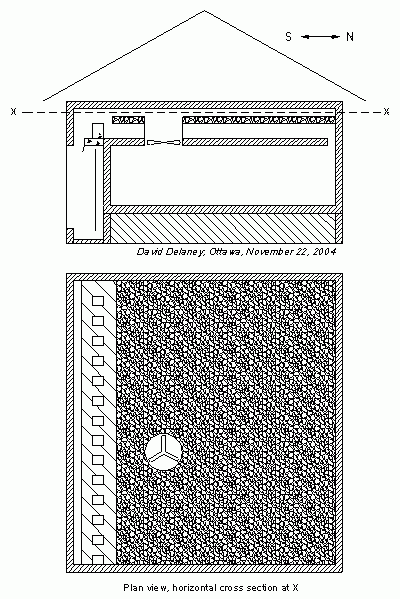 A
massive but
relatively thin layer of small
smooth river stones provides heat storage. The stones are from
1-1/2" to
2-1/2" (35 mm to 65 mm) in diameter. The stone layer is suspended
one or two
feet above the floor of the heat store attic on a wire mesh.
There
is a one foot air space above the stone layer so that hot air from air
heater can spread out above the stones. The stone layer extends above
the whole of the habitable space below. The stones present
an enormous surface area for heat transfer between stone and air.
There is very little resistance to
convective vertical flow through the stone bed because of its very
large horizontal cross sectional area. To match the volume flow
rate of air
coming up
from the air heater, air will move down through the stones at a volume
rate equal to the volume rate of the air rising from the flow
organiser. The rate of descent through the stones will be the
volume rate divided by the effective duct area of the stones. The
effective duct area of the stones will be approximately the product of
the void fraction and the area of the top of the stone bed. Given
that the stone bed extends over the whole of
the living area, the velocity of air descending through the
stones will not exceed about a twentieth of the velocity of the
air rising by natural convection through the flow organiser. As a
result, resistance to
the flow through the stone bed is small enough that convective forces
within the stone bed are sufficient to drive the necessary volume of
air throught it. (See a more
detailed description of the convective air flow here, with a
calculation of convective forces and resistance to flow through the
stone bed.) 100 lb of stone per square foot of
ceiling area
(490 kg/m2) is about right to produce the desired thermal capacity. 100
lb/ft2 corresponds to a 1 ft
(0.3 m) depth of stone with a 40% void fraction. The heat store attic
extends 3 to 4 ft (0.9 to 1.2 m) from its floor to its ceiling.
A
massive but
relatively thin layer of small
smooth river stones provides heat storage. The stones are from
1-1/2" to
2-1/2" (35 mm to 65 mm) in diameter. The stone layer is suspended
one or two
feet above the floor of the heat store attic on a wire mesh.
There
is a one foot air space above the stone layer so that hot air from air
heater can spread out above the stones. The stone layer extends above
the whole of the habitable space below. The stones present
an enormous surface area for heat transfer between stone and air.
There is very little resistance to
convective vertical flow through the stone bed because of its very
large horizontal cross sectional area. To match the volume flow
rate of air
coming up
from the air heater, air will move down through the stones at a volume
rate equal to the volume rate of the air rising from the flow
organiser. The rate of descent through the stones will be the
volume rate divided by the effective duct area of the stones. The
effective duct area of the stones will be approximately the product of
the void fraction and the area of the top of the stone bed. Given
that the stone bed extends over the whole of
the living area, the velocity of air descending through the
stones will not exceed about a twentieth of the velocity of the
air rising by natural convection through the flow organiser. As a
result, resistance to
the flow through the stone bed is small enough that convective forces
within the stone bed are sufficient to drive the necessary volume of
air throught it. (See a more
detailed description of the convective air flow here, with a
calculation of convective forces and resistance to flow through the
stone bed.) 100 lb of stone per square foot of
ceiling area
(490 kg/m2) is about right to produce the desired thermal capacity. 100
lb/ft2 corresponds to a 1 ft
(0.3 m) depth of stone with a 40% void fraction. The heat store attic
extends 3 to 4 ft (0.9 to 1.2 m) from its floor to its ceiling.A ducted ceiling fan moves hot air from above the stone layer down into the living space. A conventional 4 ft (1.2 m) diameter ceiling fan is located in the lower end of a 4.5 (1.4 m ) diameter circular duct that runs from the ceiling of the living space up through the lower part of heat store attic, then up through the stone layer to the top of the stone layer. The ceiling fan operates at reduced speed, and consumes 50 watts or less when running. It might be powered by a small area of solar photovoltaic panel. Control of the temperature of the living space can be very simple: a thermostat that turns on the fan when the living space is colder than desired.
A large solar air heater, super insulation, and thermally efficient windows that are not too large, are required to get all needed space heat from the sun in Ottawa Ontario. Ottawa has a difficult December, with 1483 F heating degree days below 64.4F, (824 C heating degree days below 18 C) (according to NASA). The average December temperature is 14F (-10C). In December, a total of 2.16 kWh per day of solar radiation falls on each square meter of a south facing vertical surface (NASA). Design calculations are currently based on the assumption that the air heater can transfer 50% of the December incident solar energy into the attic heat store as heat.
Dimensions and suitable R values for a small bungalow in Ottawa, Ontario: Living space: 40 ft (12.2m) east-west, 30 ft (9.1 m) north-south, 1200 square feet (112 m2). Insulation: ceiling of heat store attic : R 100 (RSI 17.6); walls of heawt store attic: R 57 (RSI 10); walls of living space R 50 (RSI 8.8); underslab: R20 (RSI 3.5). Windows: window R-value: R 4 (RSI 0.7 ); window area: 120 square feet (11.1 m2). Fresh air: 45 ft3/min (21 l/s) The air heater must have an area of 430 ft2 (40 m2), which could be achieved with an east-west glazing 40 ft (12.2 m) long and 11 ft (3.4 m) high. These air heater dimensions are based on the assumption that the air heater can transfer 50 per cent of the energy of the solar radiation that falls on the exterior of its glazing into the attic heat store. The calculations to justify these specifications, and to create the graphs below, may be seen in 100% Solar heated house with attic heat store for Ottawa, Ontario. (PDF)
AT 430 ft2 (40 m2) the air heater is sufficient for December space heat, but 30% larger than is needed for either November or January, the next most demanding months. The surplus heat available in the less demanding winter months might be used to heat domestic hot water. The air-water heat exchanger might be placed in the top of the attic heat store directly above the air heater, where it would be accessible for maintenance and repair.
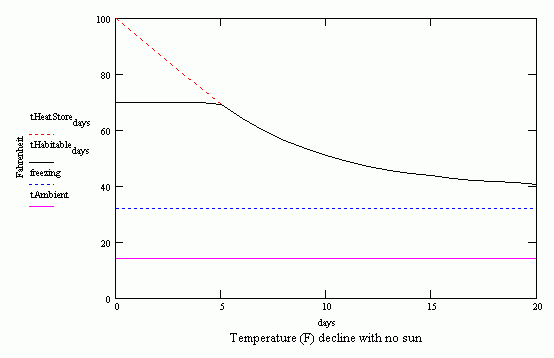 A
stone layer area of 1100 ft2
(102 m2) at 100 lb (45.5 kg) of stone per square foot provides a
thermal
capacity of 22,000 Btu/F (11.6 kWh/C). Assume a non solar heat gain of
600 W, of which 200 W is due to two human bodies. If the
temperature of the stones is 100 F (38 C) and the outdoor temperature
is 14 F (-10 C) when the sun ceases to shine for several days, and the
fan is controlled to maintain a desired temperature of 70 F (21 C), the
temperature of the habitable space will not fall below that desired
temperature until after 120 hours of darkness, and will fall to 59.8F
after 168 hours of darkness, and to 39.1 F (4 C) after 20 days of
darkness. This calculation is quite conservative. In Ottawa, a
prolonged period of no-sun days is almost always accompanied by
relatively warm weather, say around 32 F (0 C). When the temperature
descends to 14F ( -10 C) , as in this calculation, or lower, there is
almost always some clear sky each day.
A
stone layer area of 1100 ft2
(102 m2) at 100 lb (45.5 kg) of stone per square foot provides a
thermal
capacity of 22,000 Btu/F (11.6 kWh/C). Assume a non solar heat gain of
600 W, of which 200 W is due to two human bodies. If the
temperature of the stones is 100 F (38 C) and the outdoor temperature
is 14 F (-10 C) when the sun ceases to shine for several days, and the
fan is controlled to maintain a desired temperature of 70 F (21 C), the
temperature of the habitable space will not fall below that desired
temperature until after 120 hours of darkness, and will fall to 59.8F
after 168 hours of darkness, and to 39.1 F (4 C) after 20 days of
darkness. This calculation is quite conservative. In Ottawa, a
prolonged period of no-sun days is almost always accompanied by
relatively warm weather, say around 32 F (0 C). When the temperature
descends to 14F ( -10 C) , as in this calculation, or lower, there is
almost always some clear sky each day.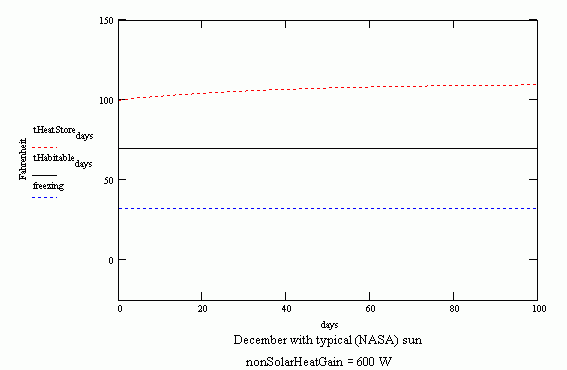 The 430 ft2 (40 m2)
air heater specified above can maintain the average temperature of the
heat store (the attic heat store) at 110 F (43 C) and the habitable
space at 70 F (21 C) during an Ottawa December of infinite duration but
typical temperatures and sun. (with 600 W non-solar heat gain).
The 430 ft2 (40 m2)
air heater specified above can maintain the average temperature of the
heat store (the attic heat store) at 110 F (43 C) and the habitable
space at 70 F (21 C) during an Ottawa December of infinite duration but
typical temperatures and sun. (with 600 W non-solar heat gain).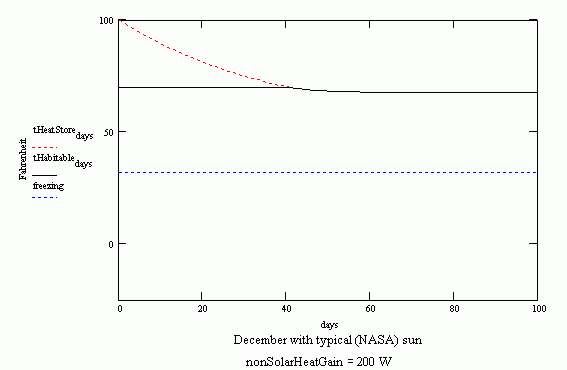
If the utility electricity fails in a typical December, but there is PV power to run the fan, the temperature of the habitable space will not fall below the desired temperature unless there is a long string of no-sun days. (Assuming a 200 W non-solar heat gain, just the two human bodies). As the graph to the right shows, the heat store (the attic heat store) even in the absence of dark days, the temperature falls to equal (a comfortable) habitable space temperature, making it impossible to maintain this temperature during multiple dark days. Backup heat might be desired to anticipate multiple dark days during a prolonged December electrical utility failure. Backup heat would not be needed for prolonged electrical failures in other months. A wood or propane cooking stove would provide sufficient backup heat.
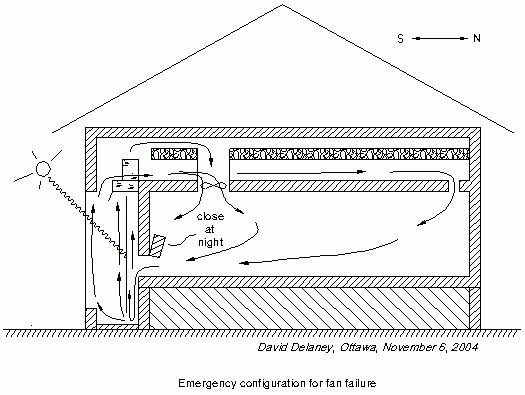 If
there is a failure of the fan or of the electricity
supply that drives the fan, a door, a window, or a special
opening in the south wall of the house may be opened during the day,
producing the flow pattern through the house and air heater shown to
the right. The air heater will be less efficient in this configuration,
and much of the benefit of the attic thermal mass will be lost,
but substantial solar heat gain will still occur. The thermal
mass will still keep the attic heat store hot, providing some
heat at night by radiation to the living space below and
eliminating heat loss from the
living space through its ceiling.
If
there is a failure of the fan or of the electricity
supply that drives the fan, a door, a window, or a special
opening in the south wall of the house may be opened during the day,
producing the flow pattern through the house and air heater shown to
the right. The air heater will be less efficient in this configuration,
and much of the benefit of the attic thermal mass will be lost,
but substantial solar heat gain will still occur. The thermal
mass will still keep the attic heat store hot, providing some
heat at night by radiation to the living space below and
eliminating heat loss from the
living space through its ceiling.References
1] Flow organizer: Organizing the air flow between a thermosyphon solar air heater and a thermal mass located above it.2) Calculation of solar gain and heat loss for the example house: 100% Solar heated house with attic heat store for Ottawa, Ontario.
3) A detailed description of the convective air flow through the heat store, with a calculation of convective forces and resistance to flow through the stone bed.
4) Calculation of the diffusion of moisture from attic heat store to cold air heater
Home